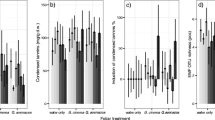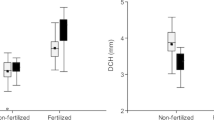Abstract
Seedling growth and ectomycorrhizal colonization of Pinus radiata and P. patula seedlings growing in nursery containers with two application rates of spores of 3 different ectomycorrhizal fungi, Helvella lacunosa, Russula brevipes and Lycoperdon perlatum, was evaluated at 5 and 12 months. At 5 months of growth P. patula was less susceptible than P. radiata to colonization by fungi and percentage of ectomycorrhizal feeder roots was lower in all treatments. Growth response (either volume or top dry weight) to treatments was different among pines species. A significant seedling growth response was observed after 5 months in both pine species with the double rate of spores of either H. lacunosa or L. perlatum; this response was sustained in P. patula at 12 months with Helvella only. P. radiata seedlings inoculated with the double rate of spores of R. brevipes showed a significant growth response at 12 months.
Resumen
Se estudió en dos intervalos del crecimiento de Pinus patula y P. radiata, en envases de vivero, la inoculación con dos dosis de esporas de los hongos ectomicorrícicos Helvella lacunosa, Russula brevipes y Lycoperdon perlatum. P. patula se mostró, en la temprana edad (5 meses) menos susceptible a la colonización radicular por bongos; la proporción de sus raicillas micorrizadas es, en todos los tratamientos, mas baja que la del otro pino. La respuesta a la inoculación (volumen o peso seco) es diferente en las dos especies de pinos; a los 5 meses se observa en ambos un respuesta significativa a la doble dosis de esporas tanto de Helvella como de Lycoperdon. Esta respuesta es consistente a los 12 meses solo en P.patula inoculado con esporas de Helvella; en esta misma etapa, las plantulas de P.radiata inoculadas con la doble dosis de esporas de Russula mostraron una respuesta significativa en su crecimiento.
Similar content being viewed by others
References
Castellano, M. A. 1987. Ectomycorrhizal inoculum production and utilization in the Pacific Northwestern, U.S.A. A glimpse at the past, a look to the future. Proc. 7 North American Conference on Mycorrhizae, pp 290–292. In: Sylvia D. M., Hung L. L. and Graham J. H. (Eds), Gainesville, Florida.
Deacon, J. W. 1988. Introducción a la Micología Moderna. Editorial Limusa, Mexico. 350 p.
Estrada, A. and Valdés, M. 1986. El crecimiento y micorrización de plantulas de pino inoculadas con Pisolithus tinctorius en semillero o en envase de transplante. Biotica 11:137–142.
Guzmán, G. 1984. Identificación de los hongos comestibles,venenosos y alucinantes. Editorial Limusa. Mexico. 440 p.
Martínez Amores, E. 1988. Ectomicorrizacíon y crecimiento de Pinus radiata y de P. patula inoculados con esporas de diferentes hongos. Tesis de Maestráa en Ciencias, Escuela Nal. de Ciencias Biolõgicas, IPN. México.
Marx, D. H. 1976. Synthesis of ectomycorrhizae on loblolly pine seedlings with basidiospores of Pisolithus tinctorius. For. Sci. 22: 13–20.
Marx, D. H., Ruehle, J. L., Kenney, D. S., Cordell, C. E., Riffle, J. W., Molina, R. J., Pawuk, W. H., Navratil, S, Tinus, R. W. and Goodwin, O. C. 1982. Commercial vegetative inoculum of Pisolithus tinctorius and inoculation techniques for development of ectomycorrhizae on container-grown tree seedlings. Forest Sci. 28: 373–400.
Marx, D. H., Jarl, K., Ruehle, J. L. and Bell, W. 1984. Development of Pisolithus tinctorius ectomycorrhizae on pine seedlings using basidiospore-encapsulated seeds. Forest Sci. 30: 897–907.
Marx, D. H., Cordell, C. E., Kenney, D. S., Mexal, J. G., Artman, J. D., Riffle, J. W. and Molina, R. J. 1984. Commercial vegetative inoculum of Pisolithus tinctorius and inoculation techniques for development of ectomycorrhizae on bare-root tree seedlings. Forest Sci. 25: 1–101.
Marx, D. H., Cordell, C. E. and Clark, A. III. 1988. Eigth-year performance of loblolly pine with Pisolithus ectomycorrhizae on a good-quality forest site. South. J. Appl. For. 12: 275–280.
Marx, D. H., Cordell, C. E., Maul, S. B. and Ruehle, J. L. 1989. Ectomycorrhizal development on pine by Pisolithus tinctorius in bare-root and container seedling nurseries. II. Efficacy of various vegetative and spore inocula. New Forests 3: 57–66.
Medellín-Leal, F. 1978. La desertificación en México. Instituto de Investigación en Zonas Desérticas, Universidad de San luis Potosí (Eds). 129 p.
Mikola, P. 1973. Application of mycorrhizal symbiosis in forestry practice. pp 383–406. In: Ectomycorrhizae. Marks, G. C. and Koslowski, T. T. (Eds). Academic Press.
Molina, R. and Trappe, J. M. 1984. Mycorrhiza management in bare root nurseries, pp. 211–223. In: Duryea, M. L. and Landis, T. D. (Eds) Forest Nursery Manual: Production of Bare Root Seedlings. Junk, The Hague.
Perry, D. A., Molina, R. and Amaranthus, M. P. 1987. Mycorrhizae, mycorrhizospheres, and reforestation: current knowledge and research needs. Can. J. For. Res. 17: 929–940.
Quintos, M. and Valdes, M. 1987. El desarrollo de micorriza y el crecimiento de plántulas de pino real (Pinus engelmand) al inocularse con Pisolithus tinctorius. Rev. Lat. Amer. Microbiol. 29:189–192.
Ruehle, J. L., Marx D. H. and Muse, H. 1984. Calculated non-destructive indice of growth response for young pine seedlings. For. Sci. 30:469–474.
Trappe, J. M. 1971. Mycorrhiza-Forming Ascomycetes. pp 19–37. In: Hacskaylo, E. (Ed). Mycorrhizae. Misc. Publication 1189, USDA Forest Service.
Valdés, M. 1985. Survival and growth of pines with specific ectomycorrhizae after 3 years on a highly eroded site. Can. J. Bot. 64: 885–888.
Author information
Authors and Affiliations
Rights and permissions
About this article
Cite this article
Martinez-Amores, E., Valdes, M. & Quintos, M. Seedling growth and ectomycorrhizal colonization of Pinus patula and P. radiata inoculated with spores of Helvella lacunosa, Russula brevipes or Lycoperdon perlatum . New Forest 4, 237–245 (1990). https://doi.org/10.1007/BF00119203
Received:
Accepted:
Issue Date:
DOI: https://doi.org/10.1007/BF00119203




